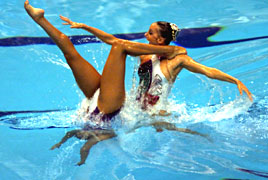
Synchronized Swimming

Synchronized Swimming, a sport often described as "dance in the water", consists of special elements like strength, flexibility, grace, artistry and long underwater endurance.
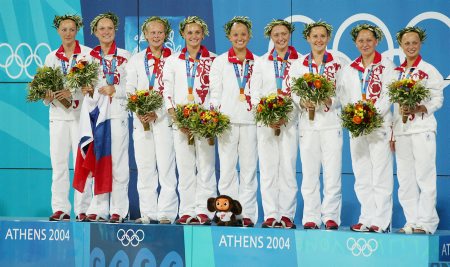
The team of Russia receiving their gold medals in the team free routine event at the Synchronized Swimming Pool in the Olympic Sports Complex Aquatic Center in Athens, on 27/08/2004
Description
Synchronized Swimming is one of only three Olympic disciplines in which only women are allowed to compete (the other two being Rhythmic gymnastics and Softball). The pool where Synchronized swimming takes place must be at least 3 m deep over a 12 x 12 m area in the center of the pool. In Olympic Synchronized Swimming any country can enter in the duet and the team event. There are two sets of marks, one for technical merit and one for artistic impression. Swimmers perform their routines in the water and are marked for both their technical merit and artistic impression.
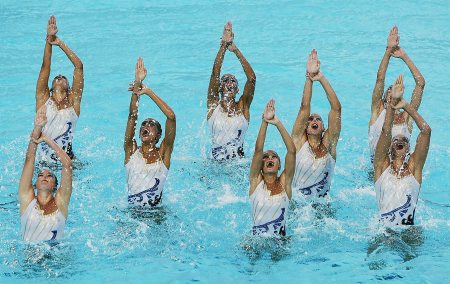
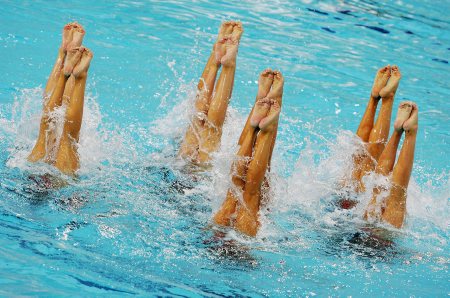
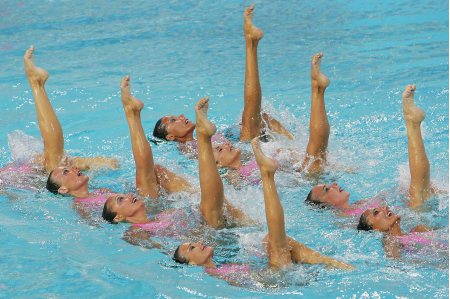
History
Synchronized swimming made its debut in Europe at the turn of the nineteenth century. Recreational activities in the water became famous thanks to the Australian swimmer Annette Kellerman (1886-1975). Kellerman toured the United States, performing acrobatic tricks in a water tank. Synchronized swimming later became well known due to US film star Esther Williams, whose water ballet was the centerpiece of many Hollywood movies. Its development as an organized sport dates from 1950. It was recognized by the International Swimming Federation (FINA) in 1952. The first meeting – an All-American Championship – was held in 1955.Synchronized swimming, individual and duet, became an official Olympic discipline at the 1984 Olympic Games in Los Angeles. The same two events remained on the programme until Atlanta (1996), when they were replaced by an event for a team of eight swimmers. At the 2004 Olympic Games in Athens there were both duet and team events as in Sydney in 2000.
In Greece, the first moves to popularize synchronized swimming were made in 1985. The Greek Swimming Federation’s decision in 1989 to develop the sport nationwide was a milestone for synchronized swimming in Greece. At first, coaches from the Federation began training selected swimmers in several different parts of Greece (Serres, Volos, Crete, Thessaloniki, Athens), in order to form a national team. The first Synchronized Swimming Open Tournament was held in Athens in 1990. A year later, Christina Thalassinidou, a Russian champion of Greek descent, took part in the European Championships held in Athens and won a silver medal for Greece, an unprecedented event for a Greek Aquatics athlete. This triumph brought changes in the club system. The vanguard units in Volos, Crete, Thessaloniki, and Athens were disbanded and the athletes transferred to clubs they were interested in. By the 1992 Greek Championships, there were eleven clubs countrywide, a fact that demonstrates the headway the sport has made in Greece.
Equipment
Costume. The swimming costume must be appropriate for a sporting event and must not be transparent.
Nose clip. This is a small wire clip sheathed in plastic that prevents water from entering the sinuses during underwater movements.
Gelatine. It is an essential aid to keep the swimmer’s hair flat while swimming. The swimmer’s hair is tied back or plastered down with gel so as not to get in the way.
Rules
The swimmers perform two routines before the judges: one technical and one free routine. The technical routine comprises obligatory elements in a prescribed order: nine in the duet and ten in the team event. The free routine allows competitors to present a composition of their own choice. There are two sets of marks, one for technical merit and one for artistic impression.
Scoring
 Technical routine. This includes obligatory elements in a
prescribed order. The time limit is 2’20” (duet) or 2’50” (team).
50% of the marks are awarded for execution and 50% for overall impression.
Technical routine. This includes obligatory elements in a
prescribed order. The time limit is 2’20” (duet) or 2’50” (team).
50% of the marks are awarded for execution and 50% for overall impression.
Free routine. This involves presentation of a
composition with free choice listed figures, strokes and/of parts thereof to
music. Again there is a time limit: 3’30” (duet) or 4’ (team). 50% of the
marks are awarded for technique and the remaining 50% for artistic impression.
The results for these two routines are combined (50% technical and 50% free choice) so as to produce the total score. Swimmers lose two points for performing technical elements in the wrong order (technical program) or for using the sides or the bottom of the pool.
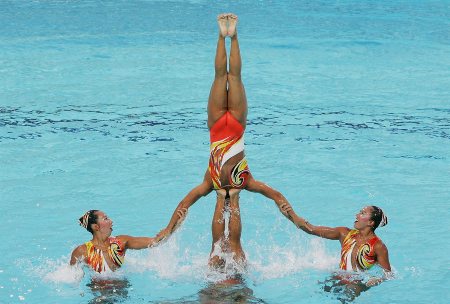
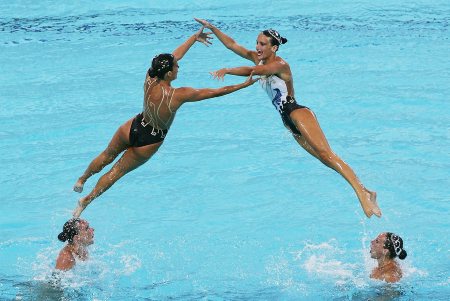
Japanese Team Italian Team
If you have any comments or questions, please type it in the box below:
This page visited already:
people